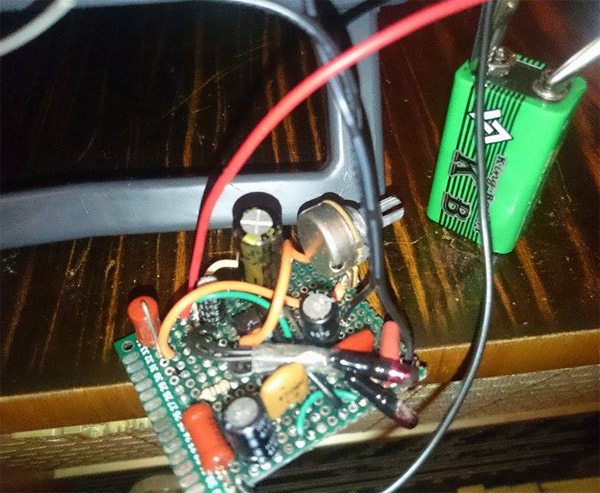
The above you see is a result of my work in which i tried to go Vintage with my design.I was talking about the usage of Vacuum tubes when i mention the word Vintage, am pretty sure you will agree to it as well.This vacuum tube oscillator can be used for testing purposes and uses diodes as an amplitude stabilization and automatic gain control.
VACUUM TUBE OSCILLATOR DESIGN:

FIRST STAGE:
This circuit is more like a version 2 of the oscillator i built earlier, where i used Triodes for first two stages.But it seemed that the input capacitance from grid to anode of the first stage was somewhat high, due to it being a triode and all.And when varying frequency of oscillations it strained the positive feedback and readjustment of the negative feedback was necessary, to bring up the oscillations again.This makes my Version 1 design extremely inconvenient.
To bypass the above problem I just replaced the input triode stage with a pentode, which uses a suppressor grid to suppress the grid to anode capacitance, which caused the loading of the positive feedback.There are still other capacitance remaining, but they`re all in-phase with the input.They will reinforce the input impedance.The only capacitance that matters is the input to anode, because the anode output is 180 degrees out of phase with the input and acts as an unintentional negative feedback.So when the capacitance of the variable capacitor falls down enough, positive feedback can no longer sustain oscillations without readjustment.
SECOND STAGE:
The second stage is part of a triode-pentode tube and works as a voltage amplifier.It boosts the input, to replenish the losses in the positive feedback and transfers it to the last stage.There is nothing unusual about it, just a common cathode voltage amplifier.
THIRD STAGE:
The last stage is a cathode follower stage or a voltage buffer which acts as a current amplifier.This boosts the current handling capabilities of the oscillator.The feedback are taken from it, so that they wont strain the voltage amplifier.The negative feedback itself contains an automatic gain control circuit, by the use of the two diodes which act as a deliberate delayed negative feedback.This will activate only when the output rises to a certain level.This way through careful adjustment you can get the gain of the amplifier to be just little over 3 to start the oscillations and when they rise to a certain level gain will fall to exactly 3 and remain there.
The advantage of this method is stability over great range of frequencies.On the other hand the disadvantage is increased nonlinear distortion of the wave.A substitute could be made with a incandescent light bulb on the other arm of the negative feedback (in series with R7), where the advantage is less distortion but also less stability over a given range of frequencies.
FREQUENCY SELECTION:
The output may also become wobbly due to the low time constant on the bulb.The positive feedback is somewhat complicated, in order to vary the frequency of the oscillations from 50Hz-50kHz.It uses a dip switch and when you want to choose a frequency range, you just enable two consecutive switches.The frequency range table of Vacuum tube oscillator is
- 4.7Mohm / 180pF – 560pF / switch 1 and 2 from left to right / 60Hz – 188Hz
- 1.5Mohm / 180pF – 560pF / switch 4 and 5 from left to right / 188Hz – 590Hz
- 470k / 180pF – 560pF / switch 5 and 6 from left to right / 590Hz – 1.88kHz
- 150k / 180pF – 560pF / switch 7 and 8 from left to right / 1.88kHz – 5.9kHz
- 50k / 180pF – 560pF / switch 9 and 10 from left to right / 5.9kHz – 17.7kHz
- 16k / 180pF – 560pF / final two switches / 17.7kHz – 55kHz
FUTURE IMPROVEMENTS:
- There were a lot of ways I thought of making this circuit.The first type was to take all the feedback from a fairly warm biased voltage amplifier, so that the output stage won`t have to deal with the strain.And then replace the output stage altogether with a transformer coupled class A amplifier.This way the transformer can provide sufficient power into decently heavy loads.But the disadvantage of this method is increased distortion and diminished frequency response from output transformer.
- These problems can probably be suppressed using very sophisticated negative feedback.But the overall quality will absolutely degrade over this option.The advantage of the current schematic is that it uses two of the most linear tube topology known.The Cathodyne phase inverter, which operates with a 50% internal negative feedback.And the cathode follower which operates at a 100% internal negative feedback.
- The phase inverter takes care of the negative feedback from the output and the distortion cancelling.Meanwhile the output stage ensures that the voltage amplifier, where most of the noise is generated will operate at best, unloaded condition where least distortion is observable.The main disadvantage of the schematic is the apparent loading of the output, which causes the output voltage to drop with heavier loads.This may lead to ceasing of oscillations at some point.
- Another future optimization may be the variable capacitor, which has a considerably low tuning range.Thus the many switches on the dip should have such a broad bandwidth.A better capacitor will be from 100pF to aroud 1.2nF.Its just what I had, and used when trying out the circuit.
- There`s a third tube I didn't include in this vacuum tube oscillator schematic, it shows an approximate output level of oscillations and the loading of the output.Its an EM80 magic eye tube and is good when testing without an oscilloscope.








